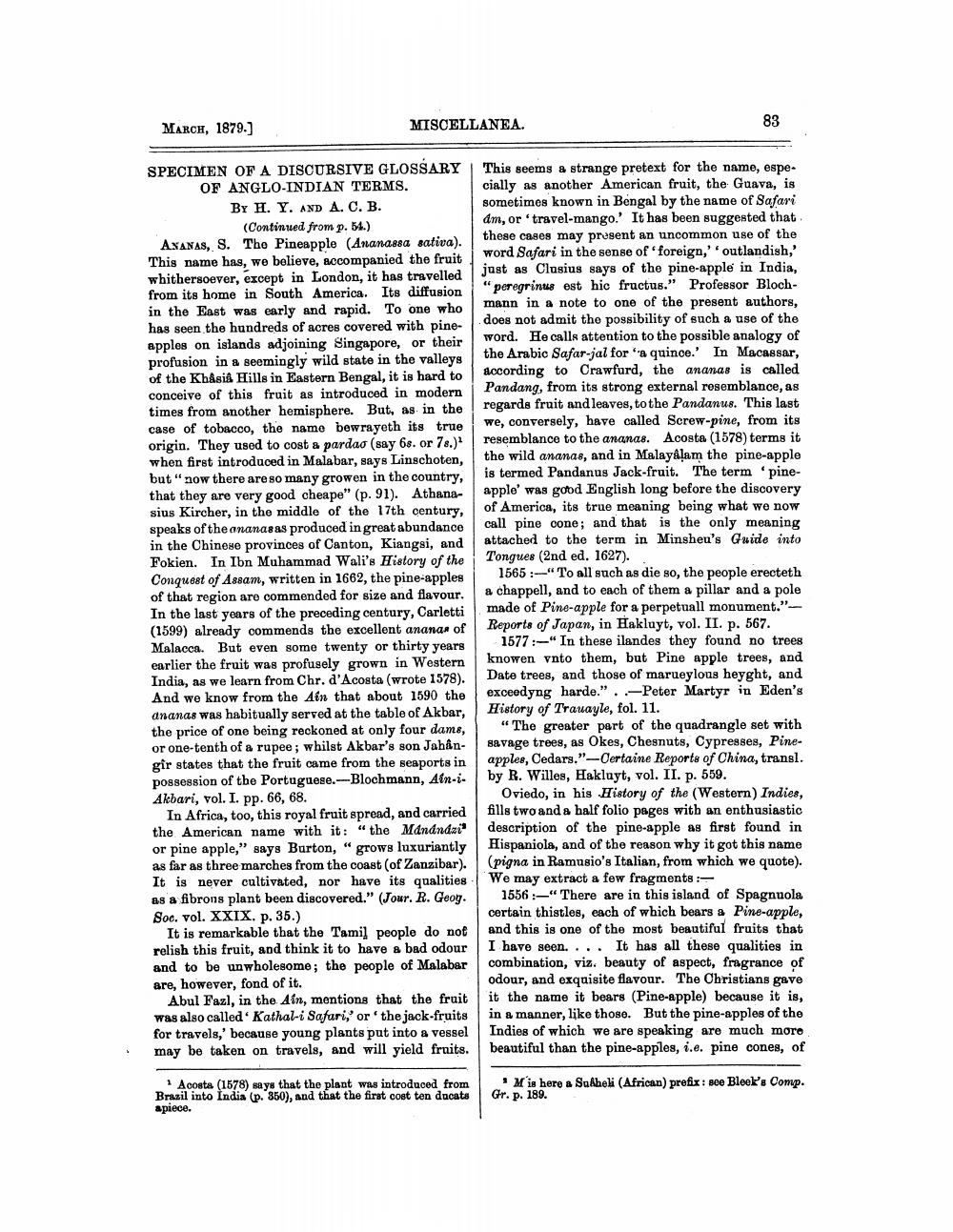________________
MARCH, 1879.]
MISCELLANEA.
SPECIMEN OF A DISCURSIVE GLOSSARY OF ANGLO-INDIAN TERMS. BY H. Y. AND A. C. B. (Continued from p. 54.)
ANANAS, S. The Pineapple (Ananassa sativa). This name has, we believe, accompanied the fruit whithersoever, except in London, it has travelled from its home in South America. Its diffusion in the East was early and rapid. To one who has seen the hundreds of acres covered with pineapples on islands adjoining Singapore, or their profusion in a seemingly wild state in the valleys of the Khasi Hills in Eastern Bengal, it is hard to conceive of this fruit as introduced in modern times from another hemisphere. But, as in the case of tobacco, the name bewrayeth its true origin. They used to cost a pardao (say 68. or 78.) when first introduced in Malabar, says Linschoten, but "now there are so many growen in the country, that they are very good cheape" (p. 91). Athanasius Kircher, in the middle of the 17th century, speaks of the ananas as produced in great abundance in the Chinese provinces of Canton, Kiangsi, and Fokien. In Ibn Muhammad Wali's History of the Conquest of Assam, written in 1662, the pine-apples of that region are commended for size and flavour. In the last years of the preceding century, Carletti (1599) already commends the excellent ananas of Malacca. But even some twenty or thirty years earlier the fruit was profusely grown in Western India, as we learn from Chr. d'Acosta (wrote 1578). And we know from the Ain that about 1590 the ananas was habitually served at the table of Akbar, the price of one being reckoned at only four dams, or one-tenth of a rupee; whilst Akbar's son Jahângir states that the fruit came from the seaports in possession of the Portuguese.-Blochmann, Ain-iAkbari, vol. I. pp. 66, 68.
In Africa, too, this royal fruit spread, and carried the American name with it: "the Manánázi or pine apple," says Burton, "grows luxuriantly as far as three marches from the coast (of Zanzibar). It is never cultivated, nor have its qualities as a fibrons plant been discovered." (Jour. R. Geog. Soc. vol. XXIX. p. 35.)
It is remarkable that the Tamil people do not relish this fruit, and think it to have a bad odour and to be unwholesome; the people of Malabar are, however, fond of it.
Abul Fazl, in the Ain, mentions that the fruit was also called Kathal-i Safari,' or 'the jack-fruits for travels,' because young plants put into a vessel may be taken on travels, and will yield fruits.
1 Acosta (1578) says that the plant was introduced from Brazil into India (p. 350), and that the first cost ten ducats apiece.
83
This seems a strange pretext for the name, especially as another American fruit, the Guava, is sometimes known in Bengal by the name of Safari am, or 'travel-mango.' It has been suggested that these cases may present an uncommon use of the word Safari in the sense of 'foreign,' outlandish,' just as Clusius says of the pine-apple in India, "peregrinus est hic fructus." Professor Blochmann in a note to one of the present authors, does not admit the possibility of such a use of the word. He calls attention to the possible analogy of
the Arabic Safar-jal for a quince.' In Macassar, according to Crawfurd, the ananas is called Pandang, from its strong external resemblance, as regards fruit and leaves, to the Pandanus. This last we, conversely, have called Screw-pine, from its resemblance to the ananas. Acosta (1578) terms it the wild ananas, and in Malayalam the pine-apple is termed Pandanus Jack-fruit. The term 'pineapple' was good English long before the discovery of America, its true meaning being what we now call pine cone; and that is the only meaning attached to the term in Minsheu's Guide into Tongues (2nd ed. 1627).
1565" To all such as die so, the people erecteth a chappell, and to each of them a pillar and a pole made of Pine-apple for a perpetuall monument."Reports of Japan, in Hakluyt, vol. II. p. 567.
1577: In these ilandes they found no trees knowen vnto them, but Pine apple trees, and Date trees, and those of marueylous heyght, and exceedyng harde.". -Peter Martyr in Eden's History of Trauayle, fol. 11.
"The greater part of the quadrangle set with savage trees, as Okes, Chesnuts, Cypresses, Pineapples, Cedars."-Certaine Reports of China, transl. by R. Willes, Hakluyt, vol. II. p. 559.
Oviedo, in his History of the (Western) Indies, fills two and a half folio pages with an enthusiastic description of the pine-apple as first found in Hispaniola, and of the reason why it got this name (pigna in Ramusio's Italian, from which we quote). We may extract a few fragments :
1556-"There are in this island of Spagnuola certain thistles, each of which bears a Pine-apple, and this is one of the most beautiful fruits that I have seen.... It has all these qualities in combination, viz. beauty of aspect, fragrance of odour, and exquisite flavour. The Christians gave it the name it bears (Pine-apple) because it is, in a manner, like those. But the pine-apples of the Indies of which we are speaking are much more beautiful than the pine-apples, i.e. pine cones, of
Mis here a Suaheli (African) prefix: see Bleek's Comp. Gr. p. 189.




